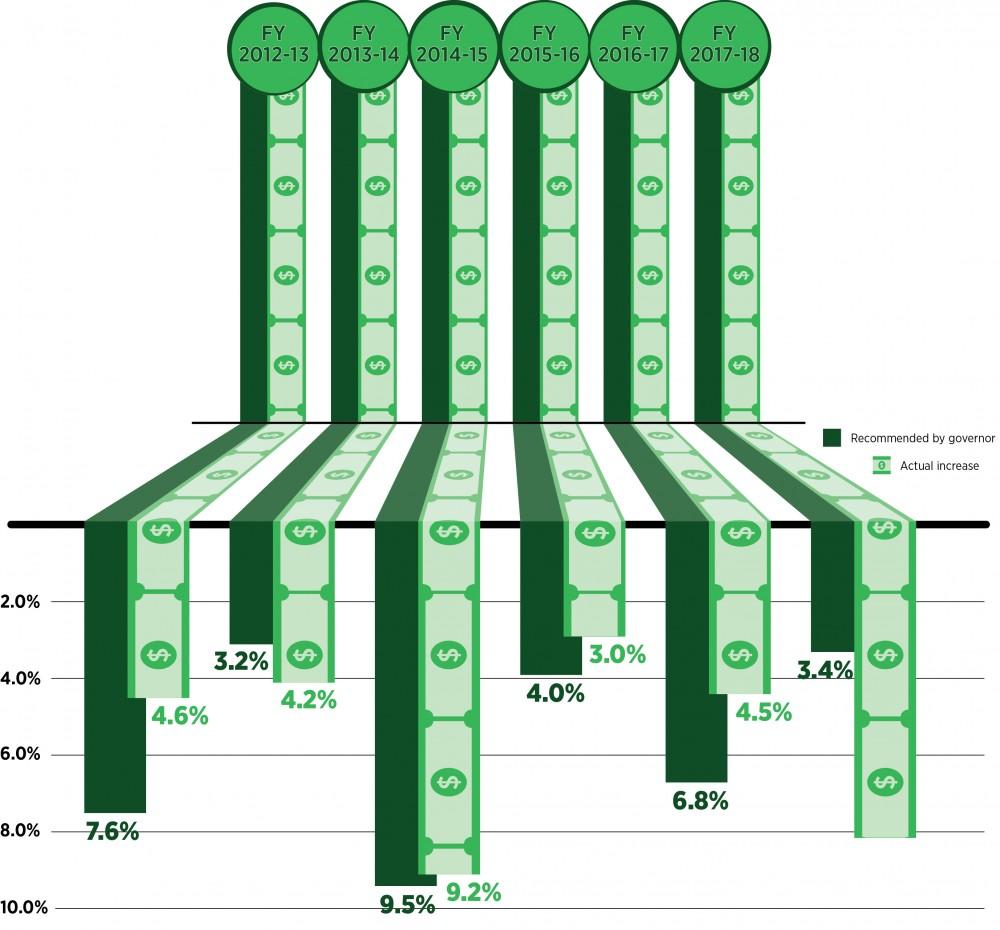Building the budget

Feb 16, 2017
Year after year, Grand Valley State University puts out performance metrics that rank among the top three in public universities in the state of Michigan. Year after year, however, GVSU does not receive near as much funding as other institutions do.
Last week, Gov. Rick Snyder released his proposed budget for the fiscal year 2018. In it was an across-the-board increase for higher education by 2.5 percent. Each school, however, received individual percent increases; GVSU was recommended for a 3.4 percent increase in state funding, the highest increase among all the universities.
Now that the governor has proposed his budget, Michigan’s House of Representatives and the Senate will make their recommendations and the finalized budget will be confirmed in the first weeks of June. The FY 2018 budget will begin Oct. 1, 2017, and will end Sept. 30, 2018.
Although the percent is the highest this year, it is not the highest increase GVSU has been recommended for, nor does that percentage equate to a large sum of money. That 3.4 percent increase GVSU has been recommended for comes out to $2,340.20, which still comes out to a dollar amount that is lower than four other schools.
In the 2016-17 school year, the state average for appropriation per student was $5,345. GVSU was below average, receiving only $3,040, the second lowest in the state.
Additionally, last year GVSU was recommended to get a 6.8 percent increase, again the highest in the state. The House of Representatives and Senate knocked down that percentage to 4.5 percent.
“One of the unfortunate aspects of the way the state handles the appropriations is that not very much of it is tested for performance,” said Matt McLogan, vice president for university relations at GVSU. “Instead, it’s handed out the way it has been over the last 30 or 40 years. So the universities that are older and larger and have more grad programs and more research do better and the newer universities, like Grand Valley, tend to do not as well in that model.
GVSU President Thomas Haas agreed, explaining the state has yet to adopt a funding process based more around performance.
“The state did not have in place any formulaic approach to allocating its dollars, and I still find that they’re only allocating half of the amount of this year to performance, the other half given across the board,” Haas said. “In all reality, only about 10 percent of the entire budget for the state of Michigan for higher education has been subjected to performance review.”
Haas does appreciate seeing GVSU as getting the highest increase, though.
“It’s very rewarding to see that our performance metrics are giving us this type of support from the state with some of their new money that they’re allocating,” he said.“I applaud the governor for staying the course on this type of approach on recognizing performance and we’re, in essence, best in class when it comes to this type of recognition.”
Performance metrics are based on six categories: undergraduate degree and completions in critical skills areas, research and development expenditures, six-year graduation rate, total degree completions, institutional support expenditures as a percentage of total core expenditures, and number of Pell grant students. And GVSU ranked first among all universities in the 2016-17 year.
The funding increase from the state would equate to approximately $2.3 million.
“Now that’s on a total budget of nearly $400 million (so) remember it’s a 3.4 percentage increase on 18 percent of our revenue not 100 percent of our revenue,” McLogan said. “The state provides 18 percent of the money needed to run the university and the rest, almost 82 percent, comes from students and their families.”
Haas reiterated that while the increase shows GVSU is being recognized, as it has in the past, it is a disappointment more funding is not coming in. He also said the appropriation process doesn’t take into account enrollment of universities.
“I’m also disappointed to some extent that the state isn’t recognizing all of the tax-payer dollars used to support higher education as it should from a policy standpoint and the other issue for us here is that we have grown in enrollment,” he said. “But we have grown in enrollment and the state doesn’t take into account any enrollment growth. So for instance, if you are shrinking, your allocation per-student goes up. And I find that to be a contributor to why our appropriations continues to be where it is.”
Haas said with the money the university does receive from the state, he uses a decent chunk to fund the Grand Finish scholarship. The Grand Finish is a program that awards seniors, who are on track to graduate in four year, with up to $1,000 in their last year as encouragement and a financial incentive to finish.
In 2011, Gov. Snyder cut the higher education budget by 22 percent, that was then mitigated to 15 percent. Since then, Snyder has slowly been increasing the funding to higher education to replace and, in essence, refund the cut the industry took.
The hope is that the 3.4 percent sticks and the House and Senate do not knock it down, as it has for the majority of past years.
“It (the increase) is an endorsement of the university’s high quality, our high graduation rate, the high quality of our students and the efficient operation of the university,” McLogan said. “All of those things are taken into account when the state produces its higher education budget and Grand Valley has done very well in that regard.
“Unfortunately it doesn’t mean a lot of money.”

























